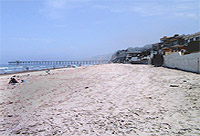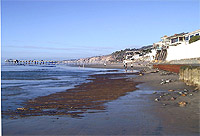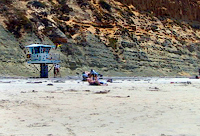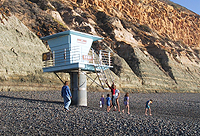Coastal Morphology Group • Scripps Institution of Oceanography
Beach as 1st Responder
 and beaches are "first responders" to storm waves.
and beaches are "first responders" to storm waves.
In Coastal Basics we showed how the beach adjusts to wave energy -
Click on buttons to make a selection.
These seasonal equilibrium profiles are created as the sand dissipates wave energy.
Without sand on the beach, wave energy cuts the platform and erodes the sea cliffs.
Consequently, the best protection for the coast and cliffs is a wide, sandy beach.
 La Jolla Shores - La Jolla, California. Zoom Sand beaches are built by low waves moving sand onshore and by currents bringing sand from upcoast. |
 La Jolla Shores - La Jolla, California. Zoom High waves from winter storms move sand offshore and expose cobbles on the platform. |
|
|
Seasonal differences in beaches located within the Oceanside littoral cell. Photographer - Pat Masters. Images used with permission. | ||
Coastal Morphology Group • Scripps Institution of Oceanography
©2002-2004 by the Regents of the University of California and the Kavli Institute.
All rights reserved.
Last modifed Thursday October 28, 2005



